Human Flower Project
P180
By on February 28th, 2022 in
Religious Rituals
Tuesday, November 02, 2004
Flowers Break through Barrier to the Spirit World
Across South Texas and much of Mexico, El Dia de Los Muertos turns loss into festivity with flowers of reunion.
Tonight there will be vigils in cemeteries all across South Texas and Mexico, as Latino families observe Day of the Dead, El Dia de Los Muertos.
This celebration as practiced today in South Texas bundles Aztec ancestor worship, Roman Catholic ritual, Halloween mischief, and schoolroom cultural history with sheaves of personal and pop cultural layering. Sacred, secular or outright silly, all observances involve flowers aplenty.
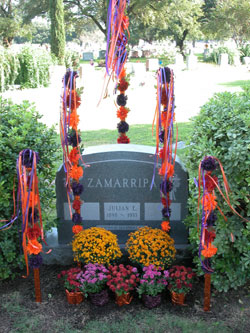
Many South Texans, like Liz Zamarripa Saenz of San Antonio, visit the family burial ground throughout the year, but All Souls is a special time. Saenz and her husband Roy cleaned the big grave marker, tidied up and decorated. This year Saenz chose her favorite colors, two big pots of golden chrysanthemums to honor her parents and five smaller chysanthemum plants, all shades of purple, to represent their five children. Around the Zamarripa headstone stand five poles covered with paper flowers and streamers that loop in the wind.
Soon her mother’s oldest friend arrives with a pot of silk cyclamen that is given a place of honor. Then Liz and Roy leave for Fort Sam Houston National Cemetery, where they’ll decorate the Saenz family plot.
Perhaps older than the custom of grave decoration is the memorial ofrenda, or altar, where the photos of loved ones are festooned with marigold garlands and surrounded by favorite foods, and beverages. There may even be a package of smokes. Traditionally, these offerings, as well as candles and the spicy scent of marigold, were thought to guide the spirits of the dead back home, making All Souls a supra-earthly reunion.
In more recent years, the custom has been adopted by arts groups, activitists, and schoolteachers hoping to impart a vivid lesson in pre-Columbian culture. “It’s been commercialized,” Liz Saenz says, “but unfortunately or fortunately, it makes no difference to us. We’ve been coming forever.”
For more on Day of the Dead celebrations around the U.S. see these stories from San Francisco, Phoenix, and even Fort Wayne, Indiana.
Monday, November 01, 2004
Campaigning with Marigolds
For Dia de los Muertos, the traditional cempasuchil flower flashes a radiant welcome across the veil of death. This year, protesters in Mexico City send a message to the living at the U.S. Embassy.
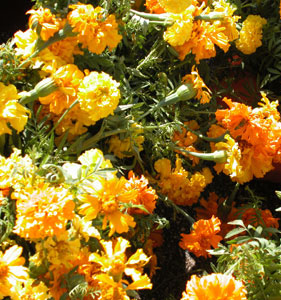
NDTV (India) reports that demonstrators in the Mexican capital spelled out “No to Bush” with mounds of blossoms Saturday in front of the U.S. Embassy.
“Mexicans prepare similar offerings as they honour the dead on November 1, when the souls of dead children are believed to return, and on November 2, when adults are believed to arrive.”
Cempasuchil flowers, much like the marigold, smell pungent and fix the eyes with oranges and yellows as high-beam as runways lights. For All Saints and All Souls Days (Nov. 1-2) these blooms are used on memorial altars (ofrendas) to draw back spirits of the dead, a tradition that combines Aztec ancestor worship and Roman Catholicism’s holidays of All Saints and All Souls days.
Over the past dozen or so years, this strong tradition has fanned from its place of origin, Southern Mexico, out across North America and other parts of the world both in personal tributes to the dead and, more recently, as a sensuous and compelling medium for all kinds of artistic and political expression.
According to NDTV, “Protesters hung art that incorporated images of Iraqi prisoners being abused. One sign labelled the US Embassy the ‘embassy of death.’”
Can anyone send us a photo of the protest?
Wednesday, October 27, 2004
Memorials: Running on Psychic Time
An Ontario town debates maintaining a floral tribute, memorial to a local teenager.
Memory can be so unpleasant, so inconvenient, downright unattractive.
Just this week newspapers reported on a new pharmaceutical that may numb and shrivel the memory of traumatic events. This particular drug may be new but it’s an old endeavor. Anybody ever heard of wine?
With flowers, people take a wiser approach. Rather than squelching memories , flowers revive them, but in a new, bright, and conspicuously formal way. By their tenderness and transience, flowers both re-enact the experience of loss and buffer pain.
This week a Canadian newspaper reports one town’s debate over a floral tribute to a teenage girl who was murdered two years ago. After Robbie McClennan was killed in Dragonfly Park in 2002, flowers were laid at the park entrance.
The Orangeville (Ontario) Bulletin reported yesterday that “a request to remove the flowers came to council in June, when East Entrance Beautification committee member Dave Ferrier said the park needs to shake the image of murder.” A public meeting on the topic was cancelled, and both the city and local newspapers received heaps of letters on the topic. “These flowers are not placed there as a reminder of murder,” one citizen wrote, “but as a memory for the grieving family and friends.”
Ferrier had proposed “a policy which prevents people from marking tragedies in this manner for more than a year.” The mayor has suggested permitting the flowers to remain “until after the murder trial comes to a close.” I don’t believe there’s any way to regulate how or how long people will “mark a tragedy.” Custom may dictate that a widow wear black for a year, but the heart (another word for memory) keeps a schedule of its own.
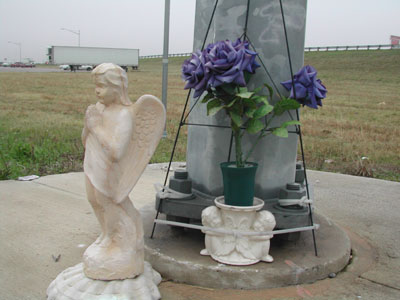
Roadside Memorial, Seguin, TX
Photo: Julie Ardery
Monday, October 25, 2004
Korean Floral Customs Change but White Wreaths Have the Last Word
Koreans are enjoying orchids, now plentiful for the first time, but for obsequies they still choose the traditional white chrysanthemum.
A column in today’s Manila Bulletin report on flower trends in Korea. Dr. Benito S. Vergara observed that Koreans, who ten years ago might splurge on one or two cut orchid flowers, today are treating themselves to arrangements of 6-12 live orchid plants, even during the winter months. Seoul hotels, restaurants and business offices are “awash with phalaenopsis and dendrobium flowers,” the story reports. The Korean government and cut-flower producers have stepped up production so that these once exotic varieties are now affordable.
Vergara, recently back from a trip to Korea, observes, ” The yellow single-headed, large mums used to be the standard flowers during autumn. We did not see any of them anymore this year. However, the white mums are still in demand for funeral wreaths.”
Korean funeral wreaths tend to be monumental, often 10 feet in diameter, and draped with inscribed black ribbons. Monstera leaves are customarily used to offset the white flowers. “Foliage similar to kamuning or sinamomo are also used as fillers,” Vergara adds. He describes these arrangements as “standard with very little variation except where some yellow mums are added.”
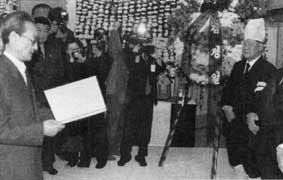
Representatives of N. Korea send condolences and white funeral wreath
Photo: The People’s Korea
A floral moment in recent Korean history occurred in March 2001, when emissaries from North Korea’s leader Kim Jong II traveled South for the funeral of Hyundai founder Jong Ju Yong, “the first time the DPRK leader has sent an official message of condolence upon the death of a South Korean.” The North Koreans paid their respects, in part, with a huge white wreath of flowers.
Evidence that the white flower presides at funerals throughout much of SE Asia (and elsewhere in the world too), is this photo from the January 2004 funeral of Hong Kong pop singer Anita Mui.
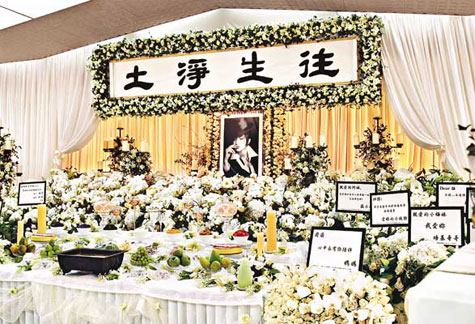
Anita Mui Kim-Fong funeral in Hong Kong, Jan. 12, 2004
Photo: the Sun
Culture & Society • Cut-Flower Trade • Religious Rituals • Permalink

